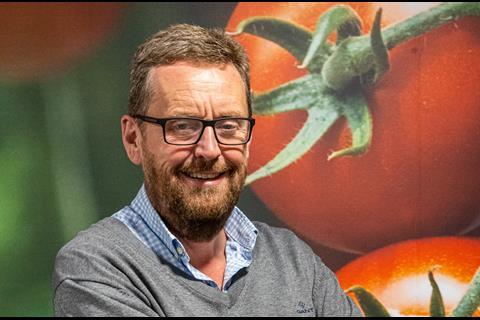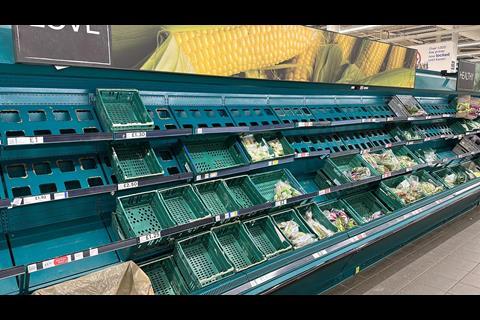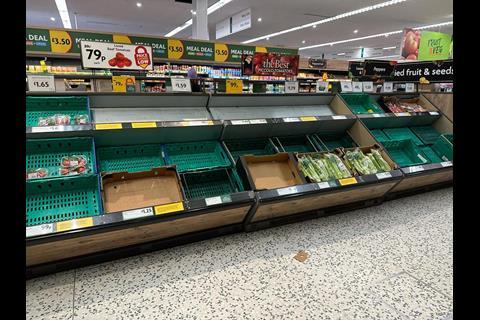Extreme weather events are principal cause of industry’s chronic supply shortages and sky-high spot prices, according to Tim O’Malley of Nationwide Produce
Erratic and unusual growing conditions, not inflation, are the main cause of the chronic supply shortages and astronomical spot prices seen across a number of fresh produce categories in Britain.
This was the emphatic message from group managing director of Nationwide Produce, Tim O’Malley, who stressed that “Mother Nature” is “the biggest issue we now have as an industry”.
The weather, rather than inflation, was the “the talk of the show” at Fruit Logistica, he said. And volatile growing conditions linked to climate change have seen spot prices shoot up and remain high across a number of different fruit and vegetables.
“There’s no greater barometer of supply and demand for produce than the spot price,” said O’Malley, “and I can honestly say that in the 40 years I’ve been in this trade, I’ve never seen such high spot prices across such a broad range of products for such a prolonged period of time.”
He gave the following examples in a market update written on 14 February:
| Product | Current spot price per box delivered | Approx. normal spot price at this time of year |
|---|---|---|
|
Yellow peppers |
£22 |
£8-£9 |
|
Red peppers |
£21 |
£8-£9 |
|
Green peppers |
£13 |
£7-£8 |
|
Round tomatoes |
£14 |
£6-£8 |
|
Cherry tomatoes |
£17 |
£5-£6 |
|
Aubergines |
£18 |
£6-£8 |
|
Courgettes |
£12 |
£5-£7 |
|
Cucumbers |
£16 |
£5-£7 |
|
Iceberg |
£19 |
£6-£8 |
|
Cos |
£15 |
£7-£8 |
|
Gem |
£18 |
£10-£12 |
|
Broccoli |
£20 |
£8-£10 |
|
Cauliflower |
£14 (was £24 last week) |
£6-£8 |
|
Red cabbage x25kg net |
£15 |
£7-£9 |
|
Dutch onions x4kg net |
£700/tonne |
£250-£280/t |
“The spot job is running at 100-200 per cent above the norm. Depending on the crop, inflation would account for around 20-40 per cent of that,” he said.
“The biggest issue we now have as an industry is not inflation, it’s Mother Nature. She’s wiping the floor with inflation.
“So, what does this mean? For the retailers: empty shelves. We’re already seeing it. The retailers are locked in a price war and reluctant to move on price, so I’m afraid they will continue to suffer from major shortages. We’re seeing empty shelves now and I can only see it getting worse over the next few weeks and months.
“With regards to foodservice and wholesale, poor availability will continue – although hopefully we’ll start to see a reduction in the exceptionally high prices we are experiencing now.
“That said, I very much doubt spot prices will drop back to normal levels for the rest of this season. I expect prices to remain relatively high. It’s yet another increased cost burden that the hospitality industry needs like a hole in the head.”
Era of cheap produce ‘must end’
The Nationwide Produce boss complained that despite all the pressures on growers and suppliers, demand for cheap food at retail was driving down domestic fruit and vegetable production and increasing the need for imports.
“Growers are being asked to carry the risk of battling against Mother Nature in return for a low-price contract that customers see as the norm,” he said.
“With ever-increasing extreme weather patterns, the risk-to-reward ratio for growers is becoming unbearable. The era of cheap fresh produce needs to come to an end.”
Weather woes
According to O’Malley, the current production problems began with Europe’s summer heatwave and drought, which was followed by a “very mild autumn” and a winter “deep freeze” that saw temperatures drop to -15°C in Catalonia.
“Spain is our main source of fresh produce in winter by far,” he said. “And they’ve pretty much gone straight from a red-hot summer to a freezing cold winter with no autumn in between.
“All crops will suffer, even protected crops, when you experience such a sharp drop in temperature. All this has led to a major reduction in yields, a reduction in size, quality issues, viruses, thrips, botrytis etc.”
Spain isn’t the only country to suffer with adverse weather of course. O’Malley also pointed to prolonged periods of sub-zero temperature in Morocco, another major source of fresh produce for Britain in the winter, and major problems for UK vegetable growers.
“We have a proper storm brewing on a range of vegetable crops,” he said. “After the warmest summer on record, Britain suffered a cold snap in December that saw temperatures countrywide dip as low as -8°C for a prolonged period.
“This caused frost damage to various crops such as carrots, parsnips, cabbage and over-wintered cauliflower, resulting in many fields being written off. We are about to see serious shortages and price hikes on these lines in the coming weeks and months.”
Spanish shortfalls
Looking at Spanish production in greater detail, Nationwide’s technical team in Almeria reported the following crop shortfalls due to cold weather in January:
- Tomatoes -35 per cent
- Cucumbers -50 per cent
- Aubergines -35 per cent
- Courgettes -40 per cent
- Peppers -40 per cent
In cucumbers, Nationwide reported a significant decrease in the production and availability in Almeria and Granada, with adverse growing conditions contributing to an increase in viruses. These conditions continue to seriously affect crops, resulting in general crop failures and product shortages.
Meanwhile, in peppers the season has been “tremendously complicated”, the supplier said, due to erratic temperatures, poor fruit set, and the appearance of tobacco thrips – a virus previously associated with ornamental plants. These factors have combined to cause a significant drop in volumes.
In addition, aubergine production has been “severely reduced” due to climatic changes. The fruit suffers more than other products from extreme temperature differences and sudden drops in temperature affect fattening. Twenty-degree swings between day and night have severely reduced production.
Tomatoes, however, are the most affected product in terms of yield, with the appearance of devastating disease ToBRV causing the collapse of some crops.






